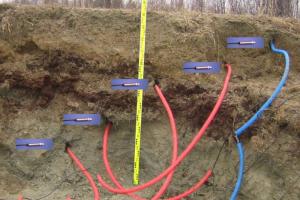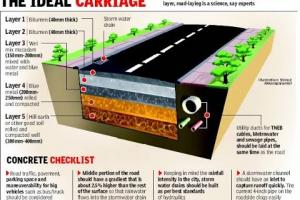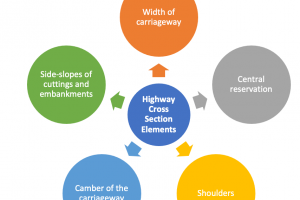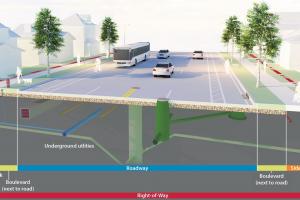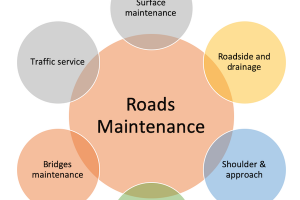Types of Surface Distresses in Road Pavements

There are several types of surface distresses that can occur in road pavements. These distresses can vary in severity and can affect the overall performance and durability of the pavement. Here are some common types of surface distresses in Road pavement:
Longitudinal Wheel Path Cracking (LWP)
Cracks which follow a course predominantly parallel to the pavement center line and are located at or near the center of the wheel path.
Possible Causes:
- Heavy traffic during spring thaw when pavements are weak.
Longitudinal Joint Cracking (LJC)
Cracks which occur along or in the immediate adjacent vicinity (i.e. +/- 300 mm) of the longitudinal center or lane line pavement joint.
Possible Causes:
- Poor construction of longitudinal joint.
- Frost action on adjacent lanes with variable granular depths.
- Differential frost heave along the center line caused by the insulating value of snow along pavement edges.
- Moisture changes resulting in swelling and shrinkage
Also See: Types of Roads | Roads Maintenance
Pavement Edge Cracking (PEC)
Cracks which occur parallel to and within 300 mm of the inside and/or outside of the pavement edge line marking (i.e. fog line). Cracks may be crescent shaped cracks or other fairly consistent cracks which intersect the pavement edge.
Possible Causes:
- Frost action
- Inadequate pavement structural support at the pavement edge and/or excessive traffic loading.
- Poor drainage at the pavement edge and shoulder.
- Inadequate pavement width forces traffic too close to the pavement edge.
Transverse Cracking
Cracks that are predominantly perpendicular to the pavement centre line and may extend fully or partially across the roadway.
Possible Causes:
- Surface shrinkage caused by low temperatures.
- High temperature susceptibility of the asphalt cement binder in asphalt mixes.
- Frost action.
- Reflection cracks.
Meandering Longitudinal Cracking (MLC)
Longitudinal cracks which wander from edge to edge of the pavement or run parallel to the centre line, situated near the middle of the lane. Meandering longitudinal cracks are usually single cracks, but secondary cracks can develop in areas where transverse cracks also exist.
Possible Causes:
- Frost action with greater heave at the pavement centre than at the edges. This is more prevalent in mixes where asphalt stripping is extensive.
- Faulty construction equipment can cause weak planes in the mix, which can fail from thermal shrinkage
Alligator Cracking (AC)
Cracks which form a network of multi-sided blocks resembling the skin of an alligator. Block size can range in size which indicates the depth of failure taking place. The pattern of cracking is usually longitudinal, originating in the wheel paths, but can occur transversely due to frost heaves or settlement and also along the centre line on narrow two lane roads.
Possible Causes:
- Usually areas subjected to repeated traffic loadings.
- Insufficient bearing support due to poor quality base materials or saturated base with poor road drainage.
- Stiff or brittle asphalt mixes at cold temperatures.
Rutting (RUT)
Longitudinal depressions left in the wheel paths after repeated loadings, combined with sideways shoving of the pavement material.
Possible Causes:
- Poorly compacted structural layers.
- Heavy loadings of saturated unstable granular bases/sub-bases during spring thaw periods.
- Unstable asphalt mixes due to high temperature or low binder viscosity.
- Inadequate lateral support from unstable shoulder materials.
- Permanent deformation of an overstressed subgrade.
Shoving
Longitudinal displacement of a localized area of the pavement surface generally caused by braking or accelerating vehicles and usually located on hills, curves or intersections.
Possible Causes:
- Stop and start of vehicles at intersections.
- Heavy traffic on steep downgrades or upgrades.
- Low stability asphalt mix.
- Lack of bond in asphalt surface and underlying layer
- Unstable granular base
Distortion
Any deviation of the pavement surface from its original shape other than that described for shoving and rutting. Generally, distortions result from settlement, slope failure, volume changes due to moisture changes and to frost heaving, and from residual effects of frost heaving accumulating after each season.
Possible Causes:
- Differential frost heaves in poorly drained cuts, transitions and at pavement edges or centre.
- Reverse differential frost heave at culverts.
- Differential settlement of subgrade or base materials.
- Lack of subgrade support.
- Embankment slope failure
Bleeding
Excess bituminous binder on the pavement surface can create a shiny, glass-like, reflective surface that may be tacky to the touch. Bleeding quite often occurs in the wheel paths.
Possible Causes:
- Mix design deficiencies where too high an asphalt content relative to voids results in excess asphalt forced to the surface by traffic, especially on hot days.
- Paving over surfaces with severe bleeding or the application of a heavy prime or tack coat under a new pavement layer may result in excess primer bleeding through the pavement surface over a period of time.
- Poor construction of surface seal coats.
Raveling
The progressive loss of the pavement material (both aggregate particles and bituminous binder) from the surface downward, leaving a rough surface, vulnerable to weather deterioration.
Possible Causes:
- Poor adhesion of aggregates due to insufficient asphalt content, clay-coated aggregate, use of wet aggregates or stripping due to water action.
- Fracture of aggregate particles by heavy loads or natural causes. The unbound particles are then removed by traffic, reducing the depth of the asphalt.
- Poor compaction permits infiltration of water and salts which promote asphalt stripping.
- Segregated mix placed during construction.
- Aging and weathering.
Roughness
Longitudinal profile roughness measurements are collected for each wheel path on a continuous basis using a laser profiler that conforms to the FHWA Class II Profiler Specification. The data is collected continuously, and reported at 50 meter averaged intervals, as per the International Roughness Index (IRI) protocols.
Pot Holes
Bowl-shaped holes of various sizes in the pavement surface.
Possible Causes:
- Thin spot in the asphalt layer.
- Localized drainage problems such as water infiltration through poorly bonded pavement structural layers or segregated spots in the asphalt mix where coarse patches allow intrusion of water
- Asphalt mix design deficiencies.




